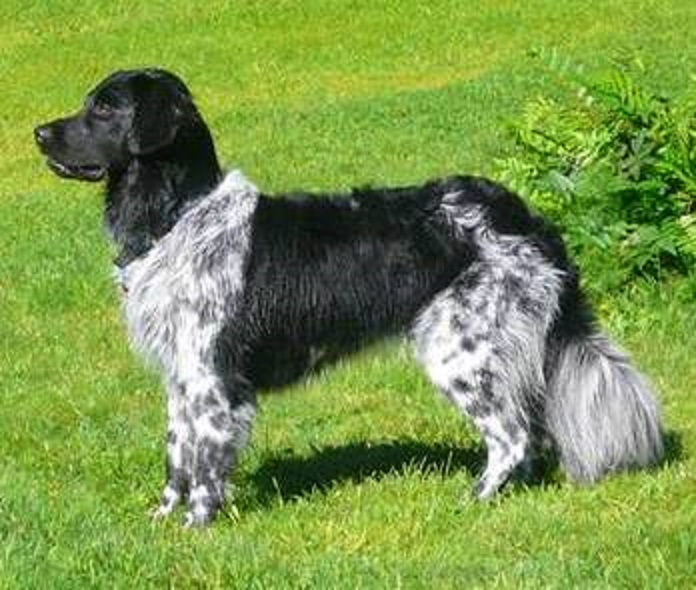
Stabyhoun

Navigate through the tabs
Navigate through the tabs below to view the breed's info of your interest.
The breed's info is divided in four sections; namely:
the breed's history ,
the breed's main stats ,
the dog's potential health issues
and finally, how the breed scored in 26 different categories.
All the above information should give you a respectively good overview for the dog of your interest.
Dog Breed's Main Info
The Breed's History:
The Stabyhoun is found in historic literature from Joost Halbertsma, Waling Dijkstra and Nynke fan Hichtum dating back to the early 1800s. In earlier days it was used for hunting foxes, small game, and birds. While on farms, Stabyhouns exhibited fine skills as a mole-catcher. During the hunting season, it was used as an all-round gundog. Today, the Stabyhoun remains a competent hunter, although British and German breeds are more popular. Renowned for its peaceful disposition, the Stabij is a soft-mouthed retriever, a fine pointer, excellent tracker, and a good watchdog. It has also been used by dairy farmers as a dog-carts.
Historically, these dogs were nearly exclusively owned by farmers, whose limited financial means dictated the need for a single farm dog capable as an all-around working, hunting, guard and house breed.
The breed's appearance and purpose have not changed. In order to optimize the working traits of the working farm dog in earlier days the Stabyhoun was often mixed with another old and rare Friesian breed, the Wetterhoun. However, in 1942 Stabij owners organized for official breed recognition and crossbreeding between the Stabyhoun and Wetterhoun was halted in an effort to prevent the extinction of the increasingly rare breeds.
In recent years some Dutch farmers started to crossbreed the Stabyhoun with the Labrador as these breeds are similar in physique, temperament and behavior. The crossbred puppies mostly resemble Labradors. Unlike Labradors, the crossbred dogs may have tuxedo markings and they may be more stubborn and slightly smaller than Labradors.
Today the Stabyhoun enjoys a small but thoroughly devoted following among Dutch sportsmen and homeowners. Its numbers are increasing slowly but steadily. This breed has caught the attention of dog lovers in the United Kingdom, Scandinavia and North America.
The working Stabyhoun
Historically, the Stabyhoun was an all-around working dog for a farmer that might be only able to afford and support a single dog that was required to be an all-around able worker that shared the home. Apart from hunting, these dogs were used to guard property and to catch rats, moles, and bunzing. This versatility is still reflected in the breed today. It is also this lack of a working specialization, the Stabij's generalization an all-rounder but not an expert at any particular skill that caused the breed to not be as sought-after traditionally.
The Stabyhoun is both a soft-mouthed retriever and a pointer with a strong tracking nose. It works very well on water, enduring the coldest rivers and lakes, and is easily controlled over greater distances. It brings in any game alive and undamaged. Although of medium build and size, it is a powerful and sturdy dog, and larger Stabyhouns of the past were occasionally used as draught animals to pull dog-carts.
The Stabyhoun is now used in almost all types of dog trials and activities: dog agility, obedience, hunting, triathlon, endurance, frisbee, and others.
Country of Origin:
Netherlands
Breed Group:
Sporting
Height:
1 foot, 7 inch. to 1 foot, 8 inch. (48,26 to 50,8 cm)
Weight:
43 to 50 pounds (19,51 to 22,68 Kg)
Life Span:
13 to 14 years
Potential Health Issues:
Epilepsy,
Hip Dysplasia
Adaptability
Apartment Living:
First Time Owners:
Sensitivity:
Being Alone:
Cold Weather:
Hot Weather:
Friendliness
Affection With Family:
With Kids:
With Dogs:
With Strangers:
Health and Grooming
Shedding:
Drooling:
Easy To Groom:
Overall Health:
Weight Gain Potential:
Size:
Training
Easiness:
Intelligence:
Mouthiness:
Prey Drive:
Barking or Howling:
Wanderlust:
Need For Exercise
Energy Level:
Intensity:
Exercise Needs:
Playfulness:
Our Mobile Application
Check out Our Mobile Application "Dog Breeds Central"
